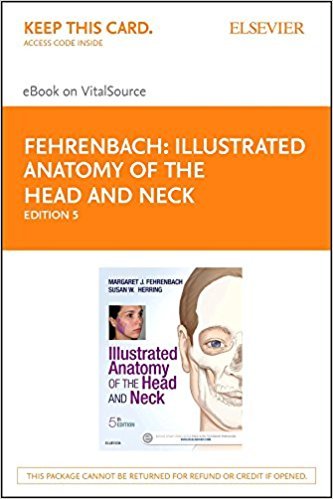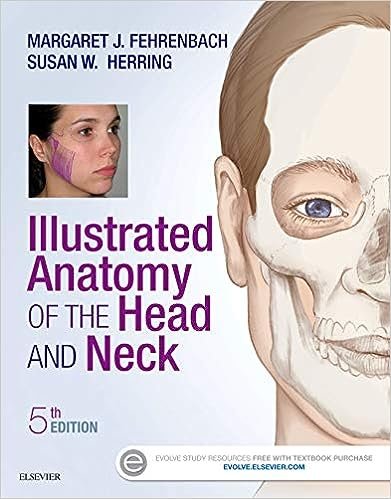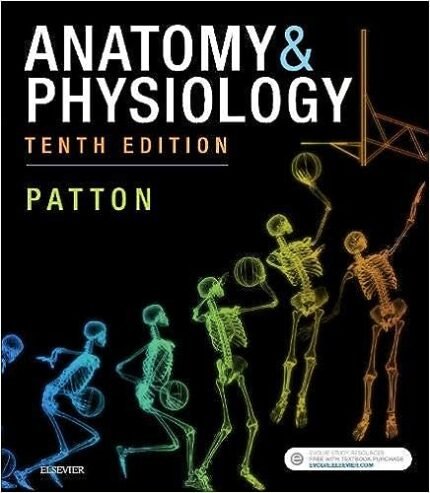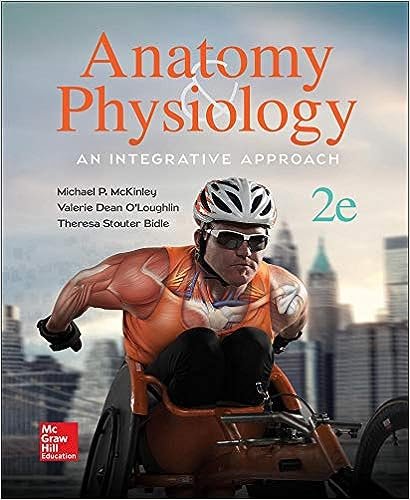Illustrated Anatomy of the Head And Neck 5th Edition By Fehrenbach RDH MS – Test Bank
Chapter 09: Anatomy of Local Anesthesia
Fehrenbach: Illustrated Anatomy of the Head and Neck, 5th Edition
MULTIPLE CHOICE
- Which of the following local anesthesia nerve blocks can be used during cosmetic restorative procedures because, after procedures are completed, the clinician can immediately and accurately access the patient’s smile line?
| a. | Anterior superior alveolar nerve block |
| b. | Posterior superior alveolar nerve block |
| c. | Anterior middle superior alveolar nerve block |
| d. | Middle superior alveolar nerve block |
ANS: C
| Feedback | |
| A | The anterior superior alveolar nerve block can cause anesthesia to the soft tissue of the patient’s lip and face. |
| B | The posterior superior alveolar nerve block can cause anesthesia to the soft tissue of the patient’s lip and face. |
| C | The anterior middle superior alveolar nerve block can anesthetize multiple maxillary teeth from the maxillary second premolar through the maxillary central incisor, ALL without causing the usual collateral anesthesia to the soft tissue of the patient’s lip and face as with most maxillary blocks near the alveolar process of the maxilla. |
| D | The middle superior alveolar nerve block can cause anesthesia to the soft tissue of the patient’s lip and face. |
DIF: Application REF: p. 216 OBJ: 2
TOP: CDA: General Chairside, I. A. Demonstrate understanding of basic oral and dental anatomy, physiology, and development | CDA: General Chairside, II. C. Describe how to perform and/or assist with intraoral procedures | CDA: General Chairside, V. A. Oral Health Information
MSC: NBDHE, Scientific Basis for Dental Hygiene Practice, 1.1 Anatomy | NBDHE, Provision of Clinical Dental Hygiene Services, 1.0 Assessing Patient Characteristics | NBDHE, Provision of Clinical Dental Hygiene Services, 3.0 Planning and Managing Dental Hygiene Care | NBDHE, Provision of Clinical Dental Hygiene Services, 4.0 Performing Periodontal Procedures
- Which of the following local anesthesia nerve blocks is usually NOT used bilaterally due to possible complications associated with swallowing and speech?
| a. | Incisive nerve block |
| b. | Inferior alveolar nerve block |
| c. | Posterior superior alveolar nerve block |
| d. | Greater palatine nerve block |
ANS: B
| Feedback | |
| A | The incisive nerve block anesthetizes teeth and tissue of the anterior and part of the most anterior part of the posterior mandible but does NOT affect speech and swallowing. |
| B | A bilateral inferior alveolar nerve block can cause complete anesthesia of the body of the tongue and floor of the mouth, resulting in speech and swallowing difficulties. |
| C | The posterior superior alveolar nerve block anesthetizes the teeth and periodontium, including buccal gingival tissue of the maxillary molars, but does NOT affect speech and swallowing. |
| D | The greater palatine nerve block anesthetizes the hard palate. Gagging by the patient may sometimes be a problem as the nearby lesser palatine nerve is also anesthetized that serves the soft palate is also anesthetized, but the patient’s speech is NOT usually affected by this block. |
DIF: Application REF: p. 224 OBJ: 2
TOP: CDA: General Chairside, I. A. Demonstrate understanding of basic oral and dental anatomy, physiology, and development | CDA: General Chairside, II. C. Describe how to perform and/or assist with intraoral procedures | CDA: General Chairside, V. A. Oral Health Information
MSC: NBDHE, Scientific Basis for Dental Hygiene Practice, 1.1 Anatomy | NBDHE, Provision of Clinical Dental Hygiene Services, 1.0 Assessing Patient Characteristics | NBDHE, Provision of Clinical Dental Hygiene Services, 3.0 Planning and Managing Dental Hygiene Care | NBDHE, Provision of Clinical Dental Hygiene Services, 4.0 Performing Periodontal Procedures
- As a result of a bicycle accident, a patient has suffered trauma to the right upper lip and maxillary right central incisor. Which of the following local anesthetic blocks may be used on the involved side when treating the injured tissue?
| a. | Anterior superior alveolar, infraorbital, and incisive nerve blocks |
| b. | Infraorbital and nasopalatine nerve blocks |
| c. | Anterior superior alveolar, middle superior alveolar, and greater palatine nerve blocks |
| d. | Infraorbital, greater palatine, and Gow-Gates mandibular nerve blocks |
ANS: B
| Feedback | |
| A | The incisive nerve block is used on the mandibular anterior teeth and premolars and does NOT provide any anesthesia to maxillary arch. |
| B | The infraorbital nerve block provides anesthesia to the maxillary facial tissue for the maxillary anteriors and the maxillary labial mucosa as well as providing anterior superior alveolar and middle superior alveolar nerve anesthesia that would anesthetize the pulp tissue of the maxillary central incisor and associated periodontium as well as nearby maxillary anteriors on the involved side. The nasopalatine nerve block anesthetizes the anterior hard palate and associated palatal gingival tissue. |
| C | The middle superior alveolar nerve block would NOT be the best choice for anesthetizing the maxillary anterior teeth since is associated mainly with anesthesia of pulp of the maxillary premolars and associated structures; additionally, the greater palatine nerve block is used ONLY for the posterior hard palate and associated palatal gingival tissue on one side. |
| D | The greater palatine nerve block is used for the posterior hard palate ONLY, and the Gow-Gates mandibular block is used to provide anesthesia to nerves that are part of the mandibular nerve or third division of the trigeminal nerve for the mandibular arch and NOT the maxillary arch. |
DIF: Application REF: p. 211 OBJ: 2
TOP: CDA: General Chairside, I. A. Demonstrate understanding of basic oral and dental anatomy, physiology, and development | CDA: General Chairside, I. B. Preliminary Physical Examination | CDA: General Chairside, II. C. Describe how to perform and/or assist with intraoral procedures | CDA: General Chairside, V. A. Oral Health Information
MSC: NBDHE, Scientific Basis for Dental Hygiene Practice, 1.1 Anatomy | NBDHE, Provision of Clinical Dental Hygiene Services, 1.0 Assessing Patient Characteristics | NBDHE, Provision of Clinical Dental Hygiene Services, 3.0 Planning and Managing Dental Hygiene Care | NBDHE, Provision of Clinical Dental Hygiene Services, 4.0 Performing Periodontal Procedures
- Orientation of the syringe for the anterior middle superior alveolar nerve block SHOULD be from the contralateral premolars. The angle of the needle SHOULD be placed at approximately 45 degrees to the injection site.
| a. | Both statements are true. |
| b. | Both statements are false. |
| c. | The first statement is true; the second is false. |
| d. | The first statement is false; the second is true. |
ANS: A
| Feedback | |
| A | The needle is placed at an approximately 45-degree angle to the injection site of the palate for the anterior middle superior alveolar nerve block. |
| B | The injection site for the anterior middle superior alveolar nerve block is approached from the contralateral maxillary premolars on the palate. |
| C | The anterior middle superior alveolar nerve block is achieved by approaching the site from the contralateral premolars and maintaining the needle at an approximately 45-degree angle to the injection site of the palate. |
| D | The anterior middle superior alveolar nerve block is achieved by approaching the site from the contralateral premolars and maintaining the needle at an approximately 45-degree angle to the injection site of the palate. |
DIF: Comprehension REF: p. 223 OBJ: 4
TOP: CDA: General Chairside, I. A. Demonstrate understanding of basic oral and dental anatomy, physiology, and development | CDA: General Chairside, II. C. Describe how to perform and/or assist with intraoral procedures | CDA: General Chairside, V. A. Oral Health Information
MSC: NBDHE, Scientific Basis for Dental Hygiene Practice, 1.1 Anatomy | NBDHE, Provision of Clinical Dental Hygiene Services, 1.0 Assessing Patient Characteristics | NBDHE, Provision of Clinical Dental Hygiene Services, 3.0 Planning and Managing Dental Hygiene Care | NBDHE, Provision of Clinical Dental Hygiene Services, 4.0 Performing Periodontal Procedures
- Which of the following local anesthetic nerve blocks uses the apex of the maxillary canine for a landmark during administration?
| a. | Infraorbital nerve block |
| b. | Anterior superior alveolar nerve block |
| c. | Middle superior alveolar nerve block |
| d. | Posterior superior alveolar nerve block |
ANS: B
| Feedback | |
| A | The height of the mucobuccal fold at the apex of the maxillary first premolar is used as the injection site for the infraorbital nerve block. |
| B | The height of the mucobuccal fold at the apex of the maxillary canine is used as the injection site for the anterior superior alveolar nerve block. |
| C | The injection site for the middle superior alveolar nerve block is at the height of the mucobuccal fold at the apex of the maxillary second premolar. |
| D | The injection site for the posterior superior alveolar nerve block is at the height of the mucobuccal fold at the apex of the maxillary second molar. |
DIF: Recall REF: p. 218 OBJ: 2
TOP: CDA: General Chairside, I. A. Demonstrate understanding of basic oral and dental anatomy, physiology, and development | CDA: General Chairside, II. C. Describe how to perform and/or assist with intraoral procedures | CDA: General Chairside, V. A. Oral Health Information
MSC: NBDHE, Scientific Basis for Dental Hygiene Practice, 1.1 Anatomy | NBDHE, Provision of Clinical Dental Hygiene Services, 1.0 Assessing Patient Characteristics | NBDHE, Provision of Clinical Dental Hygiene Services, 3.0 Planning and Managing Dental Hygiene Care | NBDHE, Provision of Clinical Dental Hygiene Services, 4.0 Performing Periodontal Procedures
- When administering a local anesthetic agent to a patient’s teeth and their related dental structures, which three bones of the head and neck have the landmarks essential for clinically effective injection technique?
| a. | Maxillae, mandible, and temporal bones |
| b. | Maxillae, mandible, and zygomatic bones |
| c. | Maxillae, mandible, and palatine bones |
| d. | Maxillae, mandible, and sphenoid bones |
ANS: C
| Feedback | |
| A | The temporal bone is NOT involved in either maxillary or mandibular injections. |
| B | The zygomatic bone is NOT involved in either maxillary or mandibular injections. |
| C | The maxillae, mandible, and palatine bones contain the foramina or alveolar processes, through which sensory nerves from dental structures travel. These bones also have external and internal landmarks that help the clinician identify target areas for needle placement. |
| D | Sphenoid bone is NOT involved in either maxillary or mandibular injections. |
DIF: Comprehension REF: p. 211 OBJ: 3
TOP: CDA: General Chairside, I. A. Demonstrate understanding of basic oral and dental anatomy, physiology, and development | CDA: General Chairside, II. C. Describe how to perform and/or assist with intraoral procedures | CDA: General Chairside, V. A. Oral Health Information
MSC: NBDHE, Scientific Basis for Dental Hygiene Practice, 1.1 Anatomy | NBDHE, Provision of Clinical Dental Hygiene Services, 1.0 Assessing Patient Characteristics | NBDHE, Provision of Clinical Dental Hygiene Services, 3.0 Planning and Managing Dental Hygiene Care | NBDHE, Provision of Clinical Dental Hygiene Services, 4.0 Performing Periodontal Procedures
- Only one injection is necessary when anesthetizing BOTH the right and left maxillary anterior palate and associated palatal gingival tissue. Pressure anesthesia during the nasopalatine local anesthetic nerve block is NOT helpful with patient comfort.
| a. | Both statements are true. |
| b. | Both statements are false. |
| c. | The first statement is true; the second statement is false. |
| d. | The first statement is false; the second statement is true. |
ANS: C
| Feedback | |
| A | The first statement is true. Both nasopalatine nerves are anesthetized with one injection. The second statement is false. Pressure anesthesia is helpful in decreasing patient discomfort. |
| B | Both the right and left nasopalatine nerves are anesthetized by the nasopalatine nerve block. Pressure anesthesia is helpful to decrease patient discomfort in this sensitive area. Thus the first statement is true, and the second statement is false. |
| C | The first statement is true. Both nasopalatine nerves are anesthetized with one injection. The second statement is false. Pressure anesthesia is helpful in decreasing patient discomfort. |
| D | The first statement is true. Both nasopalatine nerves are anesthetized with one injection. The second statement is false. Pressure anesthesia is helpful in decreasing patient discomfort. |
DIF: Application REF: p. 221 OBJ: 5
TOP: CDA: General Chairside, I. A. Demonstrate understanding of basic oral and dental anatomy, physiology, and development | CDA: General Chairside, II. C. Describe how to perform and/or assist with intraoral procedures | CDA: General Chairside, V. A. Oral Health Information
MSC: NBDHE, Scientific Basis for Dental Hygiene Practice, 1.1 Anatomy | NBDHE, Provision of Clinical Dental Hygiene Services, 1.0 Assessing Patient Characteristics | NBDHE, Provision of Clinical Dental Hygiene Services, 3.0 Planning and Managing Dental Hygiene Care | NBDHE, Provision of Clinical Dental Hygiene Services, 4.0 Performing Periodontal Procedures
- Which of the following descriptions concerning the injection site for the anterior middle superior alveolar local anesthetic nerve block is CORRECT?
| a. | Approximately midway between the median palatine raphe and the palatal gingival margin of the maxillary premolars |
| b. | Approximately10 mm medial and directly superior to the palatal gingival margin of the maxillary third molar, anterior to the depression of the greater palatine foramen |
| c. | At the height of the mucobuccal fold at the apex of the maxillary canine |
| d. | At the height of the mucobuccal fold at the apex of the maxillary first premolar |
ANS: A
| Feedback | |
| A | This injection site of approximately midway between the median palatine raphe and the palatal gingival margin of the maxillary premolars will allow penetration of the local anesthetic agent through the small pores of the maxilla of the hard palate, thus reaching the anterior to middle part of the superior dental nerve plexus. |
| B | This is the injection site for the greater palatine nerve block. |
| C | This is the injection site for the anterior superior alveolar nerve block. |
| D | This is the injection site for the middle superior alveolar nerve block. |
DIF: Comprehension REF: p. 223 OBJ: 3 | 4
TOP: CDA: General Chairside, I. A. Demonstrate understanding of basic oral and dental anatomy, physiology, and development | CDA: General Chairside, II. C. Describe how to perform and/or assist with intraoral procedures | CDA: General Chairside, V. A. Oral Health Information
MSC: NBDHE, Scientific Basis for Dental Hygiene Practice, 1.1 Anatomy | NBDHE, Provision of Clinical Dental Hygiene Services, 1.0 Assessing Patient Characteristics | NBDHE, Provision of Clinical Dental Hygiene Services, 3.0 Planning and Managing Dental Hygiene Care | NBDHE, Provision of Clinical Dental Hygiene Services, 4.0 Performing Periodontal Procedures
- Which of the following local anesthetic nerve blocks when administered together would provide the GREATEST area of anesthesia to a maxillary quadrant?
| a. | Anterior superior alveolar, posterior superior alveolar, and greater palatine nerve blocks |
| b. | Middle superior alveolar and greater palatine nerve blocks |
| c. | Middle superior alveolar, posterior superior alveolar, and greater palatine nerve blocks |
| d. | Anterior middle superior alveolar and posterior superior alveolar nerve blocks |
ANS: D
| Feedback | |
| A | The palatal tissue of the maxillary anteriors would NOT be anesthetized as well as the maxillary premolars if the middle superior alveolar nerve is present but is NOT being anesthetized. |
| B | The pulp tissue of the maxillary anterior and posterior teeth, along with their associated facial tissue, would NOT be anesthetized. |
| C | The pulp tissue of the maxillary anterior teeth and associated palatal tissue would NOT be anesthetized. |
| D | Both the anterior middle superior alveolar and posterior superior alveolar nerve blocks when administered together will anesthetize the pulp tissue of the teeth and associated facial tissue, as well as the relevant palatal tissue thus providing the greatest area of anesthesia to the maxillary quadrant. However, this protocol is NOT without its possible setbacks due to the need for large amount of agent, slow onset, and rapid removal of anesthesia with the anterior middle superior alveolar block. In addition, the block does not provide a high enough level of hemostatic control. |
DIF: Application REF: pp. 211, 221 OBJ: 2
TOP: CDA: General Chairside, I. A. Demonstrate understanding of basic oral and dental anatomy, physiology, and development | CDA: General Chairside, II. C. Describe how to perform and/or assist with intraoral procedures | CDA: General Chairside, V. A. Oral Health Information
MSC: NBDHE, Scientific Basis for Dental Hygiene Practice, 1.1 Anatomy | NBDHE, Provision of Clinical Dental Hygiene Services, 1.0 Assessing Patient Characteristics | NBDHE, Provision of Clinical Dental Hygiene Services, 3.0 Planning and Managing Dental Hygiene Care | NBDHE, Provision of Clinical Dental Hygiene Services, 4.0 Performing Periodontal Procedures
- Before periodontal scaling near the periodontal tissue clefting present on the facial surface of ALL the mandibular incisors of a patient, which local anesthetic block(s) would be the BEST to have administered bilaterally?
| a. | Infraorbital block |
| b. | Incisive block |
| c. | Mental block |
| d. | Inferior alveolar block |
ANS: B
| Feedback | |
| A | The infraorbital block provides anesthesia for the maxillary anteriors and premolars, both pulpal and for the associated facial periodontium, and can be used bilaterally without complications but does NOT provide anesthesia for the mandibular incisors. |
| B | The incisive block provides anesthesia for the mandibular anteriors and premolars, both pulpal and for the associated facial periodontium that would involve the periodontal tissue clefting, and can be used bilaterally without complications. |
| C | The mental block provides anesthesia for the mandibular anteriors and premolars but only for the associated facial periodontium, and it can be used bilaterally without complications. However, it does NOT provide pulpal anesthesia for the mandibular incisors that may be sensitive to periodontal scaling. |
| D | The inferior alveolar block provides anesthesia for the pulp tissue of ALL the mandibular teeth as well as for the associated facial periodontium of the mandibular anteriors and premolars, but it is NOT recommended to use bilaterally due to complications with swallowing. |
DIF: Application REF: p. 224 OBJ: 2
TOP: CDA: General Chairside, I. A. Demonstrate understanding of basic oral and dental anatomy, physiology, and development | CDA: General Chairside, I. B. Preliminary Physical Examination | CDA: General Chairside, II. C. Describe how to perform and/or assist with intraoral procedures | CDA: General Chairside, V. A. Oral Health Information
MSC: NBDHE, Scientific Basis for Dental Hygiene Practice, 1.1 Anatomy | NBDHE, Provision of Clinical Dental Hygiene Services, 1.0 Assessing Patient Characteristics | NBDHE, Provision of Clinical Dental Hygiene Services, 3.0 Planning and Managing Dental Hygiene Care | NBDHE, Provision of Clinical Dental Hygiene Services, 4.0 Performing Periodontal Procedures












Reviews
There are no reviews yet.